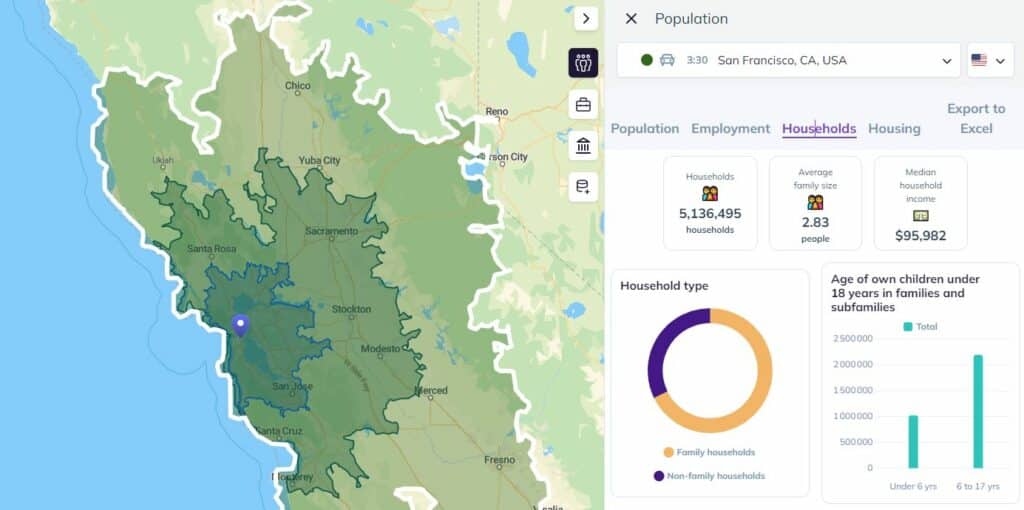Trade Areas:
A Definition and How To Analyze Yours
Picking a location for a new business isn’t as simple as visiting a few locations and picking the one that looks the best. Usually, there’s a ton of research that goes into it — a process that can potentially take months. One of the most important factors in this research? Mapping out the business’s potential trade area.
But what is a trade area? How do you map one out? And what do you need to watch out for? Let’s find out.

What is a trade area?
A trade area is a geographical area that shows where a business can expect to get most of its business. The area is drawn with a business at its centre, radiating outwards to show how far a customer is willing to travel to buy its products or services. A trade area can usually be divided up into 3 zones:
- The primary trade area, which will represent 50-75% of a business’s customer base.
- The secondary trade area, where 15-20% of a business’s customers can be found.
- The tertiary trade area, where any leftover customers usually come from.
Trade areas can be drawn before a business is established to determine where it should be opened, often using data from other locations — for a franchise — or from marketing data firms.
How is a trade area defined?
There are multiple ways to define a trade area, and the method you choose will usually depend on the resources you have on hand.
Maps and industry standards
If you’re running a small business — or otherwise don’t have a lot of resources to work with — this might be the best option. All you need to define your trade area this way is an online mapping tool (like smappen) and a bit of research.
Say, for example, that the average primary trade area for a business in your industry is five miles. Knowing this, you can use an online mapping tool, put in an address, and draw out a five-mile trade area around the address. You can also use driving times to create trade areas instead of distances. Why? They’re not affected by geographical characteristics in the same way, so you can potentially get a more accurate map.
Depending on the tool you use, this might just give you a visual representation of the trade area or it might give you a ton of useful data about the demographics of that area, which you can use to tailor your business strategy.
Using customer data
If you’re trying to choose a location for an existing business — rather than starting from scratch — you already have all the information you need to define your trade area. Just use the customer data you already have.
With a trade area mapping tool like smappen, you can import customer data to start drawing your own trade areas. As long as you have addresses tied to those customers, you can get a sense of how long they spend driving to reach your business and use that information to map out your trade area.
>> Tutorial – Importing your own data on a map
For an existing business, this is the most cost-effective way of defining your trade area by far.
Business focus groups
Instead of drawing out a trade area manually from industry data, a business might decide to use a focus group, instead. With this method, whoever’s in charge of business strategy will gather executives, leaders, and consultants in a focus group and get them to plot out a trade area.
The main advantage of this method is that you’re relying on the experience of people within the business rather than using general data that might not apply to your situation.
With a business focus group, you’ll end up with a trade area that’s tailored to your business. This can make it an incredibly valuable part of your business strategy.
Customer focus groups
With a customer focus group, you’re using a similar method to the one above, only you’re relying on the input of potential customers rather than people within the business. This is probably the most resource-intensive method, since it involves sourcing customers for interviews and workshops — usually by relying on agencies that specialize in this sort of service.
When using this method, you’ll usually ask potential customers questions like:
- How far are you willing to drive to buy this specific product or service?
- Do you typically run this kind of errand on a workday or during the weekend?
- What’s one factor that would lead you to drive a bit longer than usual for this product or service?
That kind of data can be invaluable when choosing a location for your business, but it can also inform your marketing campaigns and your business strategy as a whole.
Customer surveys
This method is less expensive than running a full focus group, and can potentially get you the same kind of data. If you’re choosing a new location for a franchise, you’ll have the advantage of already having a customer base you can survey — or prospects in an area where you’re already doing business.
But even if you don’t have a location yet, you can run a survey in the area where you’re thinking of establishing your business. There are a ton of survey providers you can work with to get this going.
Surveys can be done relatively quickly, meaning they’re a great way to get the data you need to start defining your trade area.
6 factors that can affect trade areas
Determining your trade area isn’t as simple as picking a driving time, slapping it on a map, and calling it a day. It’s also not quite as easy as just taking a focus group’s word for it. There are a few factors you have to consider as you map out your trade area:
- Population: Denser population centers lead to larger trade areas, since people are more willing to travel farther for a product or service.
- The competition: If you’re opening a furniture store just a few blocks away from a big box store, your trade area will be a lot smaller than if you were the only option nearby.
- The overall business landscape: There’s a reason businesses tend to cluster together. A healthy mix of different businesses attracts more people than a plot with just your business and a laundromat — making your trade area larger.
- Attractions: Are there any points of interest nearby? Whether it’s a large employer or a tourist destination, local attractions or points of interest can broaden your trade area.
- Traffic patterns: Highways, wide boulevards, and public transit stops are all examples of how traffic patterns can affect your trade area. If you’re near any of these points, you’ll have an easier time drawing customers from farther.
- Natural landmarks: Some natural landmarks, like mountains and rivers, can only be crossed at certain points, affecting traffic patterns and your overall trade area.
Why Trade Areas Matter
Trade areas are vital because they serve as the guiding light for businesses in numerous ways:
- Informed Location Decisions: Whether you’re launching a new venture or considering an expansion, comprehending your trade area is like having a treasure map. It helps you pinpoint the perfect location where your business can thrive, maximizing visibility and accessibility to your target audience.
- Strategic Marketing: Your trade area informs your marketing strategies. It delineates the regions where your potential customers reside, guiding your advertising efforts and ensuring you allocate resources where they are most effective.
- Overall Business Planning: Trade areas are the cornerstone of broader business strategies. From inventory management to staffing decisions, understanding your trade area is a pivotal element in crafting a comprehensive and effective business plan.
Practical applications of trade area analysis
Optimal Location Selection: For businesses looking to open new locations, trade area analysis is the compass that guides location selection. By identifying trade areas with a high concentration of potential customers, businesses can secure prime locations with confidence.
Effective Marketing Strategies: The insights gained from trade area analysis help businesses tailor their marketing efforts. Instead of casting a wide net, they can focus resources on specific areas where their target audience resides, increasing the return on investment.
Inventory Management: Understanding trade areas allows businesses to stock their inventory according to local demand. This reduces the risk of overstocking or understocking products and ensures that customers find what they need when they visit.
Growth and Expansion: As businesses grow, trade area analysis aids in identifying opportunities for expansion. It helps in evaluating the feasibility and potential success of new locations.
Tools and technologies for trade area analysis
Modern business landscapes benefit from a host of tools and technologies that aid in the analysis of trade areas. In this section, we’ll explore the available resources without delving into specific product endorsements and emphasize the role of data analytics and mapping tools in this essential process.
The Toolbox of Trade Area Analysis:
- Data Analytics: With advancements in data collection and analysis, businesses can leverage data-driven insights to refine their understanding of trade areas. Demographic, psychographic, and geospatial data, when harnessed effectively, provide valuable information about customer behaviors, preferences, and movements.
- Mapping Tools: Geospatial technology is at the forefront of trade area analysis. Interactive maps and GIS (Geographic Information Systems) enable businesses to visualize trade areas and gather insights. Mapping tools allow for the creation of visually engaging representations that can be shared and interpreted collaboratively.
- Market Research: Surveys, focus groups, and market research agencies are invaluable resources for gathering information directly from customers. They can provide qualitative data on consumer behavior, preferences, and travel distances.
- Publicly Available Data: Government agencies, such as the U.S. Census Bureau, offer publicly accessible datasets that can be used to enhance trade area analysis. These datasets include demographic and economic information.
These tools and technologies collectively empower businesses to delve deeper into their trade areas, fostering better-informed decision-making processes without explicitly promoting any particular product or service.
Using Smappen to define your business’s trade area
What’s smappen? It’s a location intelligence application that’s all about helping you use location data to make the best business decisions you can. This easy-to-use, robust tool can help you optimize your business’s logistics, choose the best location for a new operation, tailor your local marketing strategies, and more.
Because smappen gives you access to U.S. Census data, you can get the precise data you need to define your business’s trade area. And because smappen has simple area drawing tools, you can even map it yourself in a way that’s easily shared or exported for analysis and reporting.
You can start using smappen for free right now, and unlock advanced data with a paid plan.
What’ll you trade for it?
Mapping out your business’s trade area is essential for picking the perfect location, revamping your marketing efforts, and adjusting your business strategy. Whether you have the resources for a focus group or you’ll be creating the trade area on your own, you’ll see that this process can really change the game for your business.
Start using smappen now

